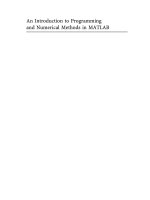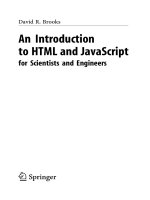C++ - I/O Streams as an Introduction to Objects and Classes
Bạn đang xem bản rút gọn của tài liệu. Xem và tải ngay bản đầy đủ của tài liệu tại đây (2.45 MB, 117 trang )
Copyright © 2007 Pearson Education, Inc. Publishing as Pearson Addison-Wesley
Chapter 6
I/O Streams as an Introduction
to Objects and Classes
Slide 6- 3
Copyright © 2007 Pearson Education, Inc. Publishing as Pearson Addison-Wesley
Overview
6.1 Streams and Basic File I/O
6.2 Tools for Stream I/O
6.3 Character I/O
6.4 Inheritance
Copyright © 2007 Pearson Education, Inc. Publishing as Pearson Addison-Wesley
6.1
Streams and Basic File I/O
Slide 6- 5
Copyright © 2007 Pearson Education, Inc. Publishing as Pearson Addison-Wesley
I/O Streams
I/O refers to program input and output
Input is delivered to your program via a stream object
Input can be from
The keyboard
A file
Output is delivered to the output device via a stream
object
Output can be to
The screen
A file
Slide 6- 6
Copyright © 2007 Pearson Education, Inc. Publishing as Pearson Addison-Wesley
Objects
Objects are special variables that
Have their own special-purpose functions
Set C++ apart from earlier programming
languages
Slide 6- 7
Copyright © 2007 Pearson Education, Inc. Publishing as Pearson Addison-Wesley
Streams and Basic File I/O
Files for I/O are the same type of files used to
store programs
A stream is a flow of data.
Input stream: Data flows into the program
If input stream flows from keyboard, the program will
accept data from the keyboard
If input stream flows from a file, the program will accept
data from the file
Output stream: Data flows out of the program
To the screen
To a file
Slide 6- 8
Copyright © 2007 Pearson Education, Inc. Publishing as Pearson Addison-Wesley
cin And cout Streams
cin
Input stream connected to the keyboard
cout
Output stream connected to the screen
cin and cout defined in the iostream library
Use include directive: #include <iostream>
You can declare your own streams to use with
files.
Slide 6- 9
Copyright © 2007 Pearson Education, Inc. Publishing as Pearson Addison-Wesley
Why Use Files?
Files allow you to store data permanently!
Data output to a file lasts after the program ends
An input file can be used over and over
No typing of data again and again for testing
Create a data file or read an output file at your
convenience
Files allow you to deal with larger data sets
Slide 6- 10
Copyright © 2007 Pearson Education, Inc. Publishing as Pearson Addison-Wesley
File I/O
Reading from a file
Taking input from a file
Done from beginning to the end (for now)
No backing up to read something again (OK to start over)
Just as done from the keyboard
Writing to a file
Sending output to a file
Done from beginning to end (for now)
No backing up to write something again( OK to start over)
Just as done to the screen
Slide 6- 11
Copyright © 2007 Pearson Education, Inc. Publishing as Pearson Addison-Wesley
Stream Variables
Like other variables, a stream variable…
Must be declared before it can be used
Must be initialized before it contains valid data
Initializing a stream means connecting it to a file
The value of the stream variable can be thought of
as the file it is connected to
Can have its value changed
Changing a stream value means disconnecting from
one file and connecting to another
Slide 6- 12
Copyright © 2007 Pearson Education, Inc. Publishing as Pearson Addison-Wesley
Streams and Assignment
A stream is a special kind of variable called
an object
Objects can use special functions to complete tasks
Streams use special functions instead of the
assignment operator to change values
Slide 6- 13
Copyright © 2007 Pearson Education, Inc. Publishing as Pearson Addison-Wesley
Declaring An
Input-file Stream Variable
Input-file streams are of type ifstream
Type ifstream is defined in the fstream library
You must use the include and using directives
#include <fstream>
using namespace std;
Declare an input-file stream variable using
ifstream in_stream;
Slide 6- 14
Copyright © 2007 Pearson Education, Inc. Publishing as Pearson Addison-Wesley
Declaring An
Output-file Stream Variable
Ouput-file streams of are type ofstream
Type ofstream is defined in the fstream library
You must use these include and using directives
#include <fstream>
using namespace std;
Declare an input-file stream variable using
ofstream out_stream;
Slide 6- 15
Copyright © 2007 Pearson Education, Inc. Publishing as Pearson Addison-Wesley
Once a stream variable is declared, connect it to
a file
Connecting a stream to a file is opening the file
Use the open function of the stream object
in_stream.open("infile.dat");
Period
File name on the disk
Double quotes
Connecting To A File
Slide 6- 16
Copyright © 2007 Pearson Education, Inc. Publishing as Pearson Addison-Wesley
Using The Input Stream
Once connected to a file, the input-stream
variable can be used to produce input just as
you would use cin with the extraction operator
Example:
int one_number, another_number;
in_stream >> one_number
>> another_number;
Slide 6- 17
Copyright © 2007 Pearson Education, Inc. Publishing as Pearson Addison-Wesley
Using The Output Stream
An output-stream works similarly to the
input-stream
ofstream out_stream;
out_stream.open("outfile.dat");
out_stream << "one number = "
<< one_number
<< "another number = "
<< another_number;
Slide 6- 18
Copyright © 2007 Pearson Education, Inc. Publishing as Pearson Addison-Wesley
External File Names
An External File Name…
Is the name for a file that the operating system uses
infile.dat and outfile.dat used in the previous examples
Is the "real", on-the-disk, name for a file
Needs to match the naming conventions on
your system
Usually only used in the stream's open statement
Once open, referred to using the
name of the stream connected to it.
Slide 6- 19
Copyright © 2007 Pearson Education, Inc. Publishing as Pearson Addison-Wesley
Display 6.1
Closing a File
After using a file, it should be closed
This disconnects the stream from the file
Close files to reduce the chance of a file being
corrupted if the program terminates abnormally
It is important to close an output file if your
program later needs to read input from the output file
The system will automatically close files if you
forget as long as your program ends normally
Slide 6- 20
Copyright © 2007 Pearson Education, Inc. Publishing as Pearson Addison-Wesley
Objects
An object is a variable that has functions and
data associated with it
in_stream and out_stream each have a
function named open associated with them
in_stream and out_stream use different
versions of a function named open
One version of open is for input files
A different version of open is for output files
Slide 6- 21
Copyright © 2007 Pearson Education, Inc. Publishing as Pearson Addison-Wesley
Member Functions
A member function is a function associated with
an object
The open function is a member function of
in_stream in the previous examples
A different open function is a member function
of out_stream in the previous examples
Slide 6- 22
Copyright © 2007 Pearson Education, Inc. Publishing as Pearson Addison-Wesley
Objects and
Member Function Names
Objects of different types have different member
functions
Some of these member functions might have the same
name
Different objects of the same type have the same
member functions
Slide 6- 23
Copyright © 2007 Pearson Education, Inc. Publishing as Pearson Addison-Wesley
Classes
A type whose variables are objects, is a class
ifstream is the type of the in_stream variable (object)
ifstream is a class
The class of an object determines its
member functions
Example:
ifstream in_stream1, in_stream2;
in_stream1.open and in_stream2.open are the same
function but might have different arguments
Slide 6- 24
Copyright © 2007 Pearson Education, Inc. Publishing as Pearson Addison-Wesley
Class Member Functions
Member functions of an object are the member
functions of its class
The class determines the member functions of
the object
The class ifstream has an open function
Every variable (object) declared of type ifstream
has that open function
Slide 6- 25
Copyright © 2007 Pearson Education, Inc. Publishing as Pearson Addison-Wesley
Calling object
Dot operator
Member function
Calling a Member Function
Calling a member function requires specifying
the object containing the function
The calling object is separated from the member
function by the dot operator
Example: in_stream.open("infile.dat");









